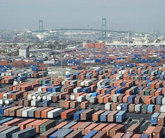Loaded containers moving through the Los Angeles-Long Beach port complex increased 4 percent in April over April 2011, with imports up 8 percent year-over-year. Containerized exports at the nation’s largest port complex declined, however, by 2 percent compared to April 2011.
April’s numbers for loaded containers at the neighboring ports tell a different story when Los Angeles is compared to Long Beach. Los Angeles had the busiest April in its history. Imports were up 16.7 percent, exports increased 11.5 percent and total loaded containers in Los Angeles were up 14.9 percent from April 2011.
The container volumes in Long Beach were down, with imports declining 13.8 percent, exports down 16.2 percent and total volume down 13 percent.
The difference is easy to explain, as last year Hyundai Merchant Marine and its terminal operator, California United Terminals, moved from Long Beach to Los Angeles. As a result, Los Angeles’ numbers this year have been running much higher than last year, while Long Beach’s numbers have been lower.
However, the increased container volume at the Los Angeles-Long Beach port complex in April is a positive development, especially with the ports’ combined imports up 8 percent.
The first quarter of 2012 ran true to form for what is happening in the trans-Pacific trade. January was a strong month for imports as U.S. importers accelerated their shipments before factories in Asia closed for two weeks in February for the Chinese New Year.
Predictably, February was a weak month, with declining imports, and March saw a return to increased imports. With the trade back to its normal cyclical flow in April, there were questions as to whether U.S. imports would increase or decrease compared to April 2011.
With Los Angeles-Long Beach accounting for about 40 percent of U.S. imports from Asia, the 8 percent increase in imports in April indicates 2012 could be a good year for retailers and carriers in the eastbound Pacific.
The Journal of Commerce Online













